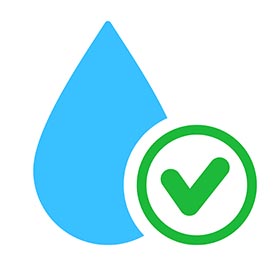Aqua Living hot tubs are not drained with each use, so it’s necessary to add chemicals to keep the water quality at a safe and pleasing level. Maintaining high water quality is also better for the tub itself. This guide will go through water chemistry basics, the various chemicals most hot tubs need and how to use those chemicals.
Water Chemistry Basics
The chemistry of your hot tub’s water must be perfectly balanced. Too many chemicals can damage the hot tub’s components, acrylic surface, hot tub cover and sensitive skin. Too few chemicals can allow mineral build-up and bacteria growth.
Several factors will influence your hot tub’s water chemistry:
- The water used to fill the tub (there may be differences in local water sources).
- Use habits, such as how often, how many people and how long they sit.
- The temperature you set during use and non-use periods.
- Seasonal factors, such as pollen, dust, dirt, plant and animal life (hot tub covers can reduce these factors).
- Evaporation rate – as water evaporates, dissolved solids (metals, calcium, salt, etc.) do not.
- The state of your hot tub cover – if it’s not fitting properly or developing mold it won’t protect your water as well.
Keep in mind that filtration is not the same as sanitation. The best filters maintained with the highest care will reduce debris but not prevent mold and bacteria growth.
The Association of Pool and Spa Professionals has established these chemical guidelines for hot tubs:
In order to maintain proper chemistry levels in your hot tub, observe a set schedule of testing and treating your spa. It’s recommended that you test the water twice a week even if the hot tub is not in use. If certain chemicals or minerals are too high, opt for draining and refilling over simply adding more water. No matter what, drain and replace your hot tub water ever four to six months.
When treating with chemicals to maintain the levels in the chart above, follow these four steps for proper water chemistry:
1. Total Alkalinity
Total alkalinity (TA) measures carbonates, bicarbonates, hydroxides and other alkaline substances. It also measures how well the water can resist pH level changes. If TA is too low, fluctuating pH can lead to scaling and corrosion in the tub. Correct low TA with sodium hydrogen carbonate.
2. Calcium Hardness
Calcium hardness (CH) measures the level of dissolved calcium which helps control the water’s corrosiveness. Calcium-low (“soft”) water is highly corrosive and can stain the acrylic. Calcium-high (“hard”) water can result in scale formation on the components. A mixture of 75 percent hard water and 25 percent soft water usually puts the level in the correct range if calcium is too high.
You can also use a stain and scale inhibitor. If CH is too low you can add a CH increaser. Small changes in water quantity should not alter CH after it’s balanced.
3. pH Level
The pH level measures water acidity and alkalinity. Ideal hot tub pH levels are slightly alkaline to optimize sanitizer effectiveness, maintain water comfort and prevent equipment deterioration.
Low pH is increased with sodium hydrogen carbonate and high pH is decreased with sodium bisulfate. Wait two hours after adding either before retesting. Note that pH is affected by new water, bather load, added chemicals and sanitizer type, so it’s a good idea to check its level before each use.
4. Sanitizer Levels
Sanitizer kills bacteria, algae and viruses and keeps other unwanted organisms from growing in the spa. However, too much sanitizer in the water can irritate the eyes, lungs and skin. Test your sanitizer levels before each use.
Adding the Chemicals
Before adding any chemicals, be certain the water is at least 80 degrees Fahrenheit to avoid damaging the acrylic surface. Wear safety goggles and gloves for your safety and remove the cover.
Never use bromo-chlor-dimethyl-hydantoin (BCDMH), tri-chlor chlorine or any type of compressed bromine or chlorine, acid or any sanitizer not recommended by the hot tub manufacturer.
- Fill a bucket that holds at least two gallons with warm water from the hot tub.
- Being careful to not splash chemicals onto the spa cabinet or acrylic surface, measure the recommended amount of one chemical, add it to the water and replace the chemical container lid.
- Mix the chemical thoroughly into the bucket of water.
- Remove the filter basket assembly and the filter.
- Press the primary pump button to put the pump on high speed, and once it’s running add the water and chemical mixture into the filtration cannister. Keep a safe distance as you pour the liquid in.
- Repeat this process with each chemical you need to add.
- When all chemicals have been added to the tub, run the pumps on high speed for ten minutes with the cover off the spa. Never leave the tub unattended when the cover is off.
- After 10 minutes, reduce pump speed to low for one full jet cycle. When the cycle is complete replace the filter and filter assembly and cover the tub.
Additional Systems for Maintaining Water Quality
Certain Aqua Living tubs come with ozone generators or chlorine generators. Ozone generators reduce the need for chemicals by reducing dissolved solids and increasing oxygen, while chlorine generators maintain chemistry by turning salt into a sanitizer.
While these systems replace some chemical usage, they do not do everything. Hot tubs with ozone systems will still need sanitizers, and hot tubs with chlorine generators will not necessarily get accurate readings on sanitation levels.
For more details on chemicals and your particular hot tub, contact your local Aqua Living dealer.




